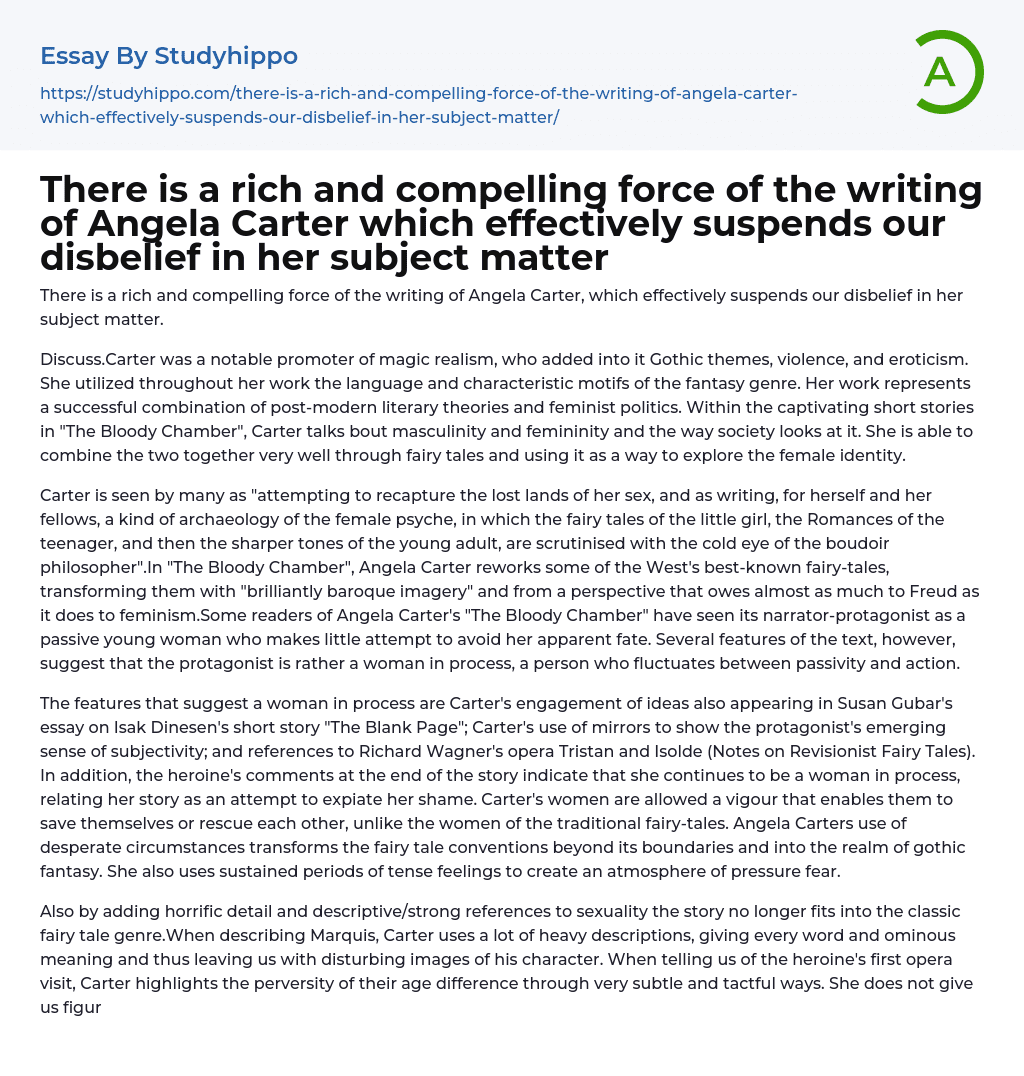Angela Carter's writing possesses a powerful and captivating force that effectively makes us overlook any doubts we may have regarding her subject matter.
Discuss. Carter was a renowned advocate of magic realism, incorporating Gothic themes, violence, and eroticism into it. She consistently integrated the language and distinct elements of the fantasy genre in her literary works. Her writing effectively fuses post-modern literary theories with feminist politics. In "The Bloody Chamber", her mesmerizing short stories address societal perceptions of masculinity and femininity. Through the use of fairy tales, Carter deftly unites the two themes, thereby exploring female identity.
Carter has been regarded by many as an individual striving to regain the lost territories of her gender. She is noted for writing an archaeological account of the female psyche for herself and her comrades, scrutinizing th
...e fairy tales of girls, the Adolescence romance stories, and the harsh tones of young adulthood with a dispassionate eye of a boudoir philosopher. In "The Bloody Chamber," Angela Carter reimagines some of the most famous fairy tales of the West. She transforms them with "brilliantly baroque imagery," using a viewpoint that draws nearly as much from Freudian thought as it does from feminism. Although certain readers have seen the narrator-protagonist in Angela Carter's "The Bloody Chamber" as an inactive young lady who makes no effort to prevent her obvious destiny, various aspects of the narrative indicate that the protagonist is a work-in-progress, someone who fluctuates between passivity and action.
Angela Carter's portrayal of a woman in process includes several features. These include her use of ideas also present in Susan Gubar's essay on Isak Dinesen's short story "The Blank Page", as well as th
use of mirrors to depict the protagonist's emerging sense of subjectivity. Carter also references Richard Wagner's opera Tristan and Isolde (Notes on Revisionist Fairy Tales). The main character's final comments reveal that she remains a woman in progress, sharing her story as an attempt to absolve herself of shame. Unlike traditional fairy-tale heroines, Carter's female characters possess strength that allows them to save themselves or each other. Desperate circumstances drive her characters beyond the boundaries of conventional fairy tales and into the realm of gothic fantasy. The use of sustained periods of tense emotions further enhances the atmosphere, instilling a sense of pressure and fear.
By incorporating graphic depictions and explicit references to sexuality, the tale can no longer be classified under the traditional fairy tale genre. Through detailed descriptions of Marquis, every word is charged with a menacing quality, leaving readers with unsettling impressions of his character. Additionally, Carter subtly emphasizes the impropriety of the heroine's age difference during her first opera outing by presenting situations rather than figures to underscore the girl's youth and Marquis' maturity.
The protagonist's initial exposure to the opera occurred when she was only a child, albeit Marquis was already wed to his opera singer spouse. Carter utilizes vivid similes and imagery relating to blood and flesh when describing the ruby chocker gifted to Marquis' inexperienced, juvenile wife. Through this technique, a morbid and peculiar atmosphere is evoked, imparting a sense of dread upon the audience. The mention of "the Terror" conjures up images of decapitated aristocrats in our minds, as the dark and red imagery takes us back to the Gothic genre, disrupting the conventional fairytale narrative.
Despite not
always relying on blood to convey fear, Carter utilizes it to demonstrate innocence and naivety. For instance, in the phrase "the blood rushed to her face again", blood symbolizes shyness. It is challenging for readers to interpret Carter's work as strictly a feminist story as its content may also present anti-feminist themes. The protagonist's behavior often projects feebleness and immaturity, allowing herself to be corrupted. Marquis infantilizes her repeatedly through his tone of speech, petting gestures, and even eye contact.
Carter effectively dispels the readers' misunderstandings by showcasing the mother as the hero with masculine traits who rescues the protagonist like a chivalrous knight. The mother's arrival on horseback is depicted with classical imagery, enhancing its impact and shattering the victim-victor binary. Through her adept use of narrative, plot, vivid imagery, and language, Angela Carter creates highly detailed and terrifying scenes that engross the reader's interest.
- Belief essays
- Deontology essays
- Ethical dilemma essays
- Moral essays
- Normative Ethics essays
- Values of Life essays
- Virtue essays
- Virtue Ethics essays
- Work Ethic essays
- Allegory essays
- Alliteration essays
- Comedy essays
- Comic book essays
- Drama essays
- Dystopia essays
- Fairy Tale essays
- Fantasy essays
- Fiction essays
- Ghost essays
- Gothic Fiction essays
- Gothic Literature essays
- Irony essays
- Legend essays
- Memoir essays
- Novel essays
- Poetry essays
- Satire essays
- Science Fiction essays
- Short Story essays
- The western essays
- Tragedy essays
- Witchcraft essays
- Atom essays
- Big Bang Theory essays
- Density essays
- Electricity essays
- Energy essays
- Force essays
- Heat essays
- Light essays
- Motion essays
- Nuclear Power essays
- Physiology essays
- Sound essays
- Speed essays
- Temperature essays
- Thermodynamics essays
- 1984 essays
- A Farewell to Arms essays
- A Good Man Is Hard to Find essays




